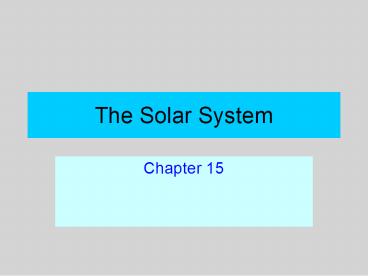The Solar System - PowerPoint PPT Presentation
1 / 18
Title:
The Solar System
Description:
Smaller bodies of the Solar System. Comets, asteroids, meteorites ... Mass of smaller bodies may be 2/3 of total Solar System mass. Bombard larger objects ... – PowerPoint PPT presentation
Number of Views:46
Avg rating:3.0/5.0
Title: The Solar System
1
The Solar System
- Chapter 15
2
Planets, moons and other bodies
- Solar System
- Sun
- 9 planets
- 100 moons
- Thousands of asteroids, millions of icy bodies,
comets, - Astronomical unit (AU)
- Average Earth-Sun distance
- 1.5x108 km
- Planet classification size, density and
atmosphere
- Terrestrial planets
- Mercury, Venus, Earth and Mars
- Mostly rocky materials, metallic nickel and iron
- Giant planets
- Jupiter, Saturn, Uranus and Neptune
- Mostly hydrogen, helium and methane
- Pluto
- In a class by itself
- True planet?
3
The order of the planets
4
Mercury
- Innermost planet
- Highly elliptical orbit
- Average distance 0.4 AU
- Orbital period 3 months
- Rotational period 59 days
- Visible shortly after sunset or before sunrise
- Highly cratered no atmosphere
5
Venus
- Orbital distance 0.7 AU
- Morning and evening star
- Exhibits phases, like the Moon
- Rotational motion opposite orbital motion
- Venusian day longer than Venusian year
- Visited by numerous probes
- Mostly CO2 atmosphere, high temperature and
pressure - Surface mostly flat but varied
6
Mars
- Orbital distance 1.5 AU
- Geologically active regions
- Inactive volcanoes
- Canyons
- Terraced plateaus near poles
- Flat regions pitted with craters
- Thin atmosphere, mostly CO2
- Strong evidence for liquid water in past
- Numerous space probes
7
Jupiter
- 5 AU from Sun
- Most massive planet
- 318 times Earths mass
- Mostly H and He with iron-silicate core
- Dynamic atmosphere
- H2, He, ammonia, methane, water,
- Great Red Spot
- 39 widely varying satellites
8
Saturn
- 9.5 AU from Sun
- Rings of particles
- Density 0.7 that of water
- Surface similar to Jupiters
- 30 satellites
- Titan only moon with substantial atmosphere
9
Uranus, Neptune and Pluto
- Uranus (19 AU) and Neptune (30 AU)
- Outermost giant planets
- Similar internal structures
- Pluto
- Smaller than the Moon
- 70 rock 30 water ice tenuous, thin atmosphere
- Unusual orbit
- Tilted 17o from ecliptic
- Crosses Neptunes
10
Planet summary
11
Smaller bodies of the Solar System
- Comets, asteroids, meteorites
- Leftover from solar and planetary formation
- Mass of smaller bodies may be 2/3 of total Solar
System mass - Bombard larger objects
- Comet Shoemaker-Levy 9 fragments (bottom)
- and strikes Jupiter (July 1994)
12
Comet origins
- Oort cloud
- Origin of long-period comets (200 years)
- 30 AU to light-year away
- Kuiper belt
- Origin of short-period comets (
- Disk-shaped region 30-100 AU from Sun
- Gravitational nudges deflect objects toward Sun
13
Comet structure
- Small, solid objects
- Dirty snowball model
- Frozen water, CO2, ammonia, and methane
- Dusty and rocky bits
- Comet head
- Solid nucleus and coma of gas
- Two types of tails
- Ionized gases
- Dust
- Tail points away from Sun
14
Asteroids
- Located in belt between Mars and Jupiter
- Sizes up to 1,000 km
- Varied composition
- Inner belt stony
- Outer belt dark with carbon
- Others iron and nickel
- Formed from original solar nebula
- Prevented from clumping by Jupiter nearby
15
Meteors and meteorites
- Meteoroids
- Remnants of comets and asteroids
- Meteor
- Meteoroid encountering Earths atmosphere
- Meteor showers Earth passing through comets
tail - Meteorite
- Meteoroid surviving to strike Earths surface
- Iron, stony (chondrites and achondrites) or
stony-iron
16
Origin of the Solar System
- Protoplanet nebular model
- Stage A
- Formation of heavy elements in many earlier stars
and supernovas - Concentration in one region of space as dust, gas
and chemical compounds
17
Origin of the Solar System
- Stage B
- Formation of large, rotating nebula
- Gravitational contraction, spin rate increases
- Most mass concentrates in central protostar
- Remaining material forms accretion disk
- Material in accretion disk begins clumping
18
Origin of the Solar System
- Stage C
- Protosun becomes a star
- Solar ignition flare-up may have blown away
hydrogen and helium atmospheres of inner planets - Protoplanets heated, separating heavy and light
minerals - Larger bodies cooled slower, with heavy materials
settling over longer times into central cores































